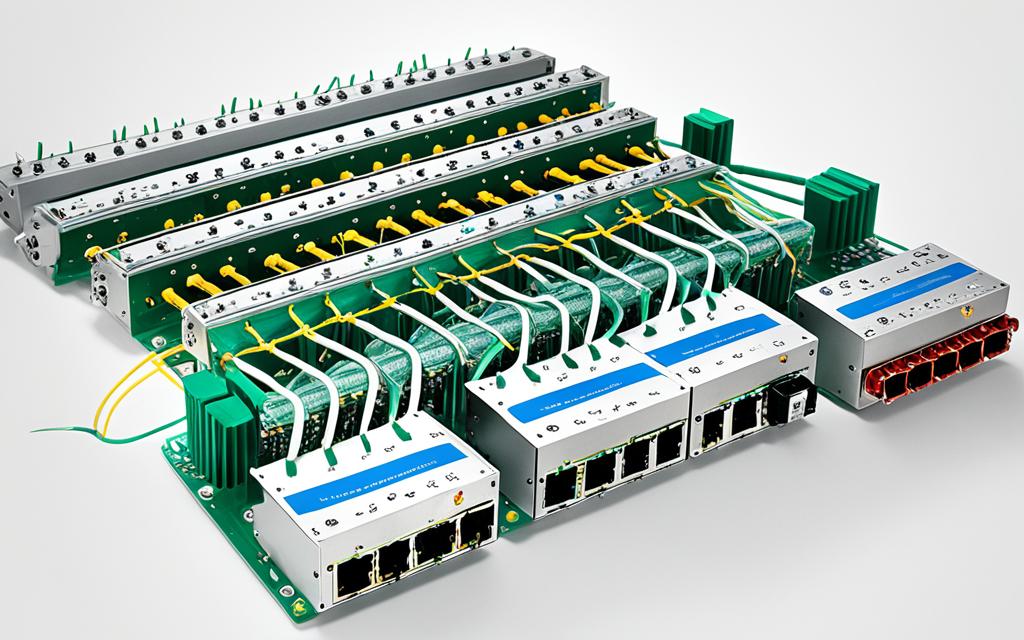Welcome to our article on Reconfigurable Optical Add-Drop Multiplexer (ROADM) technology and its role in flexible optical routing. In today’s rapidly evolving telecommunications landscape, the need for efficient and adaptable network infrastructure is paramount. The ROADM technology provides a solution that enables remote configuration and reconfiguration of lightpaths, offering unparalleled flexibility in optical routing.
An Optical Add/Drop Multiplexer (OADM) is a Wavelength Division Multiplexing (WDM) device that allows for specific wavelengths to be dropped or added at a location without terminating other wavelengths. However, basic fixed OADMs have limitations and cannot be reconfigured after deployment.
To overcome these limitations, the Reconfigurable Optical Add/Drop Multiplexer (ROADM) was introduced. ROADMs utilize advanced technologies such as Wavelength Selective Switch (WSS), allowing for dynamic adjustments in the add/drop vs. pass-through configuration. They support more than two directions and enable remote configuration of lightpaths, eliminating the need for manual patches.
With flexible-grid WSS technology, ROADMs offer greater spectral efficiency and adaptability to different channel widths and spacing. Various architectures of ROADMs, such as colorless, directionless, and contentionless, provide different levels of flexibility in wavelength assignment, add/drop direction, and wavelength routing.
By simplifying network operations, automating connections, and eliminating the need for manual patches, ROADMs enable network providers to optimize their infrastructure for efficiency, scalability, and flexibility. Stay tuned for the rest of our article to explore the various types of ROADMs and their advantages in optical network deployments.
Understanding Optical Add/Drop Multiplexers (OADMs)
An Optical Add/Drop Multiplexer (OADM) is a crucial component in Wavelength Division Multiplexing (WDM) networks. Its purpose is to enable the selective addition or removal of specific wavelengths at designated locations without affecting other wavelengths. This capability facilitates wavelength reuse and enables traffic to be routed efficiently in different directions, enhancing the overall flexibility and capacity of the network.
However, basic fixed OADMs have inherent limitations. Once deployed, they cannot be reconfigured, restricting their adaptability to changing network requirements. These fixed OADMs also have strict constraints on the number of directions they can handle, often limited to just two. Furthermore, provisioning new wavelengths or modifying paths with fixed OADMs typically involves manual intervention, requiring network technicians to physically manipulate patch cables.
Additionally, traffic volume and patterns can be challenging to adjust with fixed OADMs. They lack the ability to dynamically allocate and redistribute traffic based on real-time conditions, leading to potential congestion and suboptimal utilization of network resources.
Despite these limitations, fixed OADMs continue to be employed in certain scenarios where simple point-to-point connections or limited network requirements are sufficient. However, for more advanced network architectures that demand greater flexibility and scalability, Reconfigurable Optical Add/Drop Multiplexers (ROADMs) offer a viable solution.
ROADMs provide a dynamic and reconfigurable approach to optical network management, enabling network operators to adapt and optimize their infrastructure in response to changing traffic demands and evolving service requirements.
Table: Comparing Fixed OADMs and ROADMs
| Features | Fixed OADMs | ROADMs |
|---|---|---|
| Reconfigurability | No | Yes |
| Number of Directions | Two | Multiple |
| Traffic Adjustment | Manual | Dynamic |
| Provisioning | Manual | Remote and Automated |
Table: Comparing key features of fixed OADMs and ROADMs.
ROADMs revolutionize optical network architecture by introducing remote configuration capabilities, enabling operators to reconfigure lightpaths and adjust traffic flow without the need for physical intervention. They utilize advanced technologies such as flexible-grid Wavelength Selective Switch (WSS) to provide enhanced spectral efficiency and accommodate different channel widths and spacing.
Furthermore, various ROADMs architectures, such as colorless, directionless, and contentionless, offer heightened flexibility and increased control over wavelength routing, allowing network operators to efficiently allocate wavelengths and adapt to changing network demands. These advancements empower network providers to efficiently manage their optical networks, optimize resource utilization, and deliver scalable and flexible telecommunications services.
Introduction to Reconfigurable Optical Add/Drop Multiplexers (ROADMs)
Reconfigurable Optical Add/Drop Multiplexers (ROADMs) were introduced to address the limitations of fixed OADMs. They offer a solution for easy adjustment to changing traffic demands through remote configuration and reconfiguration of lightpaths. Unlike fixed OADMs, which cannot be reconfigured after deployment, ROADMs provide the flexibility to redirect wavelengths at intermediate sites along the path.
Initially, ROADMs utilized fixed-grid Wavelength Selective Switch (WSS) technology. However, they have evolved to support flexible-grid WSS, which offers a significant advantage in terms of spectral efficiency and cost reduction. With flexible-grid WSS, ROADMs enable different channel widths and spacing, resulting in optimized resource allocation and improved overall network performance.
There are various architectures of ROADMs, each offering different levels of flexibility in wavelength assignment, add/drop direction, and wavelength routing. These architectures include:
- Fixed Filter ROADM
- Colorless ROADM
- Directionless ROADM
- Contentionless ROADM
Let’s take a closer look at each of these architectures:
| ROADM Architecture | Features |
|---|---|
| Fixed Filter ROADM | Provides fixed add/drop filters with fixed wavelength assignment |
| Colorless ROADM | Allows flexible allocation of any wavelength or color to any port |
| Directionless ROADM | Eliminates the need for physical reconnection of transmission fibers, allowing any channel to be added and directed to any outbound nodal degree |
| Contentionless ROADM | Enables the same wavelength to be added and dropped off of a single port for different directions, eliminating wavelength blocking |
These different architectures provide network operators with the flexibility to tailor their optical networks based on specific requirements and varying network topologies. By leveraging the appropriate ROADM architecture, operators can optimize network performance, reduce complexity, and simplify network operations.

Advantages of Reconfigurable Optical Add/Drop Multiplexers (ROADMs)
Reconfigurable Optical Add/Drop Multiplexers (ROADMs) offer numerous advantages in optical networks. Their advanced capabilities provide a flexible and resilient infrastructure that meets the evolving demands of modern telecommunications. Some key advantages of ROADMs include:
1. Remote Provisioning
With ROADMs, wavelengths can be provisioned remotely from a Network Management System (NMS). This eliminates the need for manual adjustments or major network changes at each site, significantly reducing operational complexities. Remote provisioning streamlines network management and enables efficient resource allocation.
2. Dynamic Routing
ROADMs enable administrators to dynamically route individual wavelengths or groups from any site to any other site within the network. This empowers network providers to respond quickly to unpredictable traffic demands and optimize network resource utilization. Dynamic routing enhances network flexibility, allowing for efficient traffic optimization and improved service delivery.
3. Network Flexibility
ROADMs bring unparalleled flexibility to optical networks. By offering remote provisioning and dynamic routing capabilities, ROADMs allow for efficient allocation of network resources to accommodate changing traffic patterns. This flexibility ensures that network operators can deliver a wide range of service-level guarantees and rapidly adapt to evolving customer needs.
4. Network Resilience
ROADMs enhance network resilience by enabling easy reconfiguration in response to network failures or maintenance activities. Automatic rerouting of wavelengths circumvents affected network elements, reducing downtime and ensuring uninterrupted service delivery. The ability to quickly adapt to changing network conditions enhances the overall resilience and availability of the optical network.
Overall, the advantages of ROADMs contribute to more efficient, scalable, and adaptable optical network infrastructures. With remote provisioning, dynamic routing, network flexibility, and enhanced resilience, ROADMs provide the foundation for modern telecommunications networks.

Overview of Reconfigurable Optical Add/Drop Multiplexer (ROADM) Technologies
Reconfigurable Optical Add/Drop Multiplexers (ROADMs) utilize various technologies and architectures to provide flexibility and efficiency in optical networks. With different types of ROADMs available, network operators can choose the most suitable option based on their specific requirements. Let’s explore some of the key technologies in the world of ROADMs:
Colorless ROADM
Colorless ROADM is a technology that allows for the flexible allocation of any wavelength or color to any port. This means that network administrators have the freedom to assign wavelengths as needed, improving wavelength assignment flexibility. With colorless ROADM, the burdensome process of assigning specific colors to specific ports is eliminated, streamlining network operations and enabling efficient use of resources.
Directionless ROADM
The directionless ROADM technology eliminates the need for physically reconnecting transmission fibers when adding or redirecting channels. This means that any channel can be added and directed to any outbound nodal degree without requiring manual intervention. By enabling this level of flexibility, directionless ROADMs simplify network configuration and reduce the time and effort required for network changes.
Contentionless ROADM
Contentionless ROADM technology addresses wavelength blocking, a common challenge in optical networks. It allows the same wavelength to be added and dropped off of a single port for different directions, removing potential conflicts and enhancing network efficiency. With contentionless ROADMs, network providers can optimize wavelength utilization and maximize the capacity of their optical networks.
Gridless ROADM
Gridless ROADM technology offers the ability to support various channel grids within a single network. This adaptability allows the network to meet future transmission speed requirements without major modifications. Gridless ROADMs provide flexibility in channel width and spacing, catering to evolving network demands and ensuring scalability.
These different technologies and ROADMs architectures offer varying levels of flexibility and suit different network requirements. Choosing the right ROADM technology is essential for optimizing network performance and meeting the growing demands of modern optical networks.
Stay tuned for the concluding section where we will summarize the advantages and benefits of Reconfigurable Optical Add/Drop Multiplexers (ROADMs) and their impact on optical network efficiency, scalability, and flexibility.
Conclusion
Reconfigurable Optical Add/Drop Multiplexers (ROADMs) are crucial for the efficient and scalable operation of optical networks. They provide the necessary flexibility in wavelength routing, easing the provisioning process and enabling dynamic routing and network resilience. By embracing the power of ROADMs, network providers can effectively meet the changing traffic demands and quickly adapt to network alterations.
ROADMs also play a vital role in future-proofing the photonic layer of optical networks, maximizing spectral efficiency, and optimizing network resources. With their ability to simplify network operations and reduce costs, ROADMs enhance network availability and improve overall network performance. The efficiency, scalability, and flexibility offered by ROADMs empower network providers to unlock the full potential of their optical network infrastructure and deliver efficient and flexible telecommunications services.
In summary, Reconfigurable Optical Add/Drop Multiplexers (ROADMs) are essential components for modern optical networks. They revolutionize the way wavelengths are routed, providing improved efficiency and enabling network providers to adapt to the ever-changing telecommunications landscape. With their numerous advantages, including easy provisioning, dynamic routing, and network resilience, ROADMs ensure high-performance optical networks that can meet the demands of today and tomorrow.
FAQ
What is an Optical Add/Drop Multiplexer (OADM)?
An Optical Add/Drop Multiplexer (OADM) is a device used in Wavelength Division Multiplexing (WDM) networks. It allows for specific wavelengths to be dropped or added at a location without terminating other wavelengths. This enables wavelength reuse and allows for traffic to be routed in different directions.
What are the limitations of basic fixed OADMs?
Basic fixed OADMs cannot be reconfigured after deployment, are limited to two directions, and require manual patches for provisioning new wavelengths or changing their paths. Traffic volume and patterns cannot be easily adjusted with fixed OADMs.
What are Reconfigurable Optical Add/Drop Multiplexers (ROADMs)?
Reconfigurable Optical Add/Drop Multiplexers (ROADMs) were introduced to address the limitations of fixed OADMs. They enable remote configuration and reconfiguration of lightpaths, allowing for easy adjustment to changing traffic demands. ROADMs support more than two directions and can redirect wavelengths at intermediate sites along the path.
What technologies do ROADMs utilize?
Initially, ROADMs used fixed-grid Wavelength Selective Switch (WSS) technology, but they have evolved to support flexible grid, which allows different channel widths and spacing. This provides greater spectral efficiency and reduces cost, power, and space per bit.
What different architectures of ROADMs are available?
There are different architectures of ROADMs, including fixed filter, colorless, directionless, and contentionless. Each architecture offers varying levels of flexibility in wavelength assignment, add/drop direction, and wavelength routing.
What advantages do ROADMs offer in optical networks?
ROADMs provide numerous advantages in optical networks, including remote provisioning, dynamic routing, network flexibility, and network resilience. They simplify network operations, reduce costs, and enhance network availability. ROADMs also future-proof the photonic layer, ensuring compatibility with any new coherent technology.



















